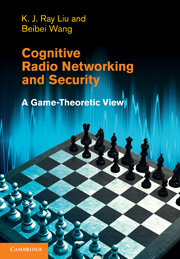Book contents
- Frontmatter
- Contents
- Preface
- Part I Cognitive radio communications and cooperation
- 1 Introduction to cognitive radios
- 2 Game theory for cognitive radio networks
- 3 Markov models for dynamic spectrum allocation
- 4 Repeated open spectrum sharing games
- 5 Pricing games for dynamic spectrum allocation
- 6 A multi-winner cognitive spectrum auction game
- 7 Evolutionary cooperative spectrum sensing games
- 8 Anti-jamming stochastic games
- 9 Opportunistic multiple access for cognitive networks
- Part II Resource awareness and learning
- Part III Securing mechanism and strategies
- References
- Index
9 - Opportunistic multiple access for cognitive networks
from Part I - Cognitive radio communications and cooperation
Published online by Cambridge University Press: 06 December 2010
- Frontmatter
- Contents
- Preface
- Part I Cognitive radio communications and cooperation
- 1 Introduction to cognitive radios
- 2 Game theory for cognitive radio networks
- 3 Markov models for dynamic spectrum allocation
- 4 Repeated open spectrum sharing games
- 5 Pricing games for dynamic spectrum allocation
- 6 A multi-winner cognitive spectrum auction game
- 7 Evolutionary cooperative spectrum sensing games
- 8 Anti-jamming stochastic games
- 9 Opportunistic multiple access for cognitive networks
- Part II Resource awareness and learning
- Part III Securing mechanism and strategies
- References
- Index
Summary
In this chapter, opportunistic multiple access to the under-utilized channel resources is investigated. By exploiting source burstiness, secondary cognitive nodes utilize primary nodes' periods of silence to access the channel and transmit their packets. Cognitive relays could also make use of these silent periods to offer spatial diversity without incurring losses of bandwidth efficiency. First, we consider the cognitive cooperation protocol and discuss two different relay-assignment schemes. A comparison of the two schemes is carried out through a maximum stable throughput analysis of the network. Then, secondary nodes' access to the remaining idle channel resources is considered. Queueing-theoretic analysis and numerical results reveal that, despite the fact that relays occupy part of the idle resources to provide cooperation, secondary nodes surprisingly achieve higher throughput in the presence of relays. The rationale is that relays help primary nodes empty their queues at faster rates; therefore, secondary nodes observe increased channel access opportunities. Moreover, the scenario where secondary nodes present themselves as relays to the primary network is also presented. By working as relays, secondary nodes further help primary nodes empty their queues, hence increasing their channel access opportunities and achieving higher throughput, as is revealed by our analytical and numerical results.
Introduction
The scarcity of energy and bandwidth, the two fundamental resources for communications, imposes severe limitations on the development of communications networks in terms of capacity and performance.
- Type
- Chapter
- Information
- Cognitive Radio Networking and SecurityA Game-Theoretic View, pp. 226 - 246Publisher: Cambridge University PressPrint publication year: 2010



